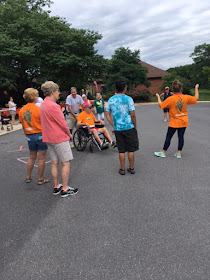The poor people of Texas are suffering through some tough times with Hurricane Harvey and the flooding aftermath. Prayers go out to all of them.
I only have a smattering of experience with Hurricanes and flooding going back to 1972's Agnes.
The Best Week of My Life


1972 was a great year. Nixon was at his peak, the Vietnam War was about to be ended and Americans had been on the Moon 5 or 6 times. My sport was basketball, and I needed to get much better at it to compete with the likes of teammate Curt Clawson (who later became the greatest shooter Coach Keady of Purdue ever saw, including Michael Jordan!) I opted for the prestigious Pocono Mountain Basketball Camp run by Coaches Bill Foster and Harry Litwack. I headed off with spirits high and with ridiculous sneakers not really suitable for basketball.
My joy turned to ecstasy when I found out that David Thompson was going to be my Coach for the week. After his sophomore year at NC State, he wasn't yet a household word, but he was certainly one of the premier young players in college ball. His teammates Monty Towe and Phil Spence were with him. Tom Burleson had gone to another camp.
The first day was spent getting to know the camp layout and the set up for the coming week of intense drills, practices and games. Then, the rain began. Hurricane Agnes had hit Florida and meandered up the East Coast, delivering torrential rains which was only was made worse when it stalled over land. Worst hit happened to be where we were in the Poconos. All roads were washed out and we were marooned at our camp. Only the two indoor courts were usable by the hundreds of kids there, many counselors staying elsewhere weren't available, and we were on our own mostly. Lord of the Flies type stuff, may I add?
When the bridge over the little stream leading to the indoor courts washed out when it became a raging river, we improvised by swinging across the stream on a rope hanging from a tree. Those little kids that invariably fell in were retrieved downstream with the help of a dam we fashioned out of canoes left over from the camp's previous life. We never lost a single camper! Each day became worse with the rain and the inability of anyone to reach us from the outside. The menu deteriorated noticeably each day, with meals becoming a mish mash of whatever was available. The nightly movie reel (the World War II flick, Triple Cross) was repeated each night, and all of us learned the entire dialog by the end of the week. We were able to shout the words to the entire movie before the actor would, which somehow never got old. I remember the joy on David Thompson's face with this each night, pure innocent joy. I find it hard to believe that he later ended his basketball career in the throes of substance abuse.
Days were spent watching the college guys play pick-up basketball. Only one court at a time was available, as they tore down rim after rim with spectacular alley-oops and jams (Monty Towe and David Thompson invented the alley-oop!) none of us could believe. Those handy with tools would remake the backboards and rims on the one court as the players switched to the other.
Players were true amateurs in those days, and none of them was receiving any money outright, just room and board (eating the same crap the rest of us were!). We supplemented David by putting quarters on top of the backboards. Any quarter he jumped up and retrieved was his by default. And he pocketed a lot of change that week. I've been challenged on this many times, but I saw him do it hundreds of times. His vertical leap was unbelievable, even with just one step. He had a kid follow him just to hold all of his quarters. And I would have volunteered for the duty if someone else hadn't gotten there first!
It was a simply magical week, and I didn't mind eating Cream of Wheat for three straight meals by the end of the week. When the rain finally stopped and my parents picked me up, I was amazed to see all of Pennsylvania flooded. We didn't have a TV and no one bothered listening to the radio, we were there to watch basketball and there was none better than what was on the court live.




























